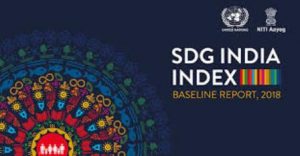NITI Aayog releases SDG India Index 2018
Himachal Pradesh and Kerala with an index of 69 are better performers whereas Uttar Pradesh with an index of 42 is the worst performer.

The NITI Aayog on Friday released the SDG India Index: Baseline Report 2018. The report analysed India’s performance in the 13 out of 17 Sustainable Development Goals (SDGs) adopted by the UN General Assembly in 2015 as Agenda 2030. “India played a crucial role in formulation of SDGs. Our performance in achieving the set targets will play crucial role in determining the success of SDGs worldwide, In such a scenario, this report acts like a mirror for India’s performance and provides insight to the policy makers in formulation of policies for the country,” the report reads.
Among the States, Himachal Pradesh and Kerala with an index of 69 have been labelled as frontrunners whereas Uttar Pradesh with an index of 42 is the worst performer.
While Kerala’s top rank is attributed to its superior performance in providing good health, reducing hunger, achieving gender equality and providing quality education, Himachal Pradesh ranks high on providing clean water and sanitation, in reducing inequalities and preserving mountain ecosystem.
“Among the UTs, Chandigarh takes the lead with an index of 68, because of its exemplary performance in providing clean water and sanitation to its people.”
It has further made good progress towards providing affordable and clean energy, generating decent work and economic growth, and providing quality education.
The report brings forth the performance of States and Union Territories with reference to the average index of India which stands at 57.
Also read: Partners’ Forum: SDG 17 in full swing with The BMJ’s 12 country case studies
India has an index score of 54 for SDG 1 which targets at poverty alleviation. The main highlight for this target has been the Tendulkar Committee report which estimates that 21.92 per cent of India’s population is below the poverty line. For SDG 2 – the target is to achieve Zero Hunger by 2030 – India’s national Index stands at a meagre 48.
The report also suggests that 38.4 per cent of children aged under five years of age stunted in India. Also, highlighting the state of pregnant women in India, the report brings to notice that 50 per cent of women between 15 and 49 are anaemic in India with the state of Jharkhand being the worst performer with an index of 35.
The national average for SDG 3 which aims to ensure that people enjoy a level of health that enables them to lead a socially and economically productive life is 52, while the SDG index score for the Goal of Good Health and Well-being ranges between 25 and 92 for States with Kerala being the top performer with an index score of 92.
“However, the index score for SDG 3 reflects huge inequalities among the States.”
With a Maternal Mortality Rate of 130 per 1,00,000 births, India has come only halfway for the targeted rate which stands at 70. Also, for every thousand live births in India, 50 children aged under five years die. The national target is to bring this rate down to 11 per thousand live births by 2030.
The national SDG Index Score for the Goal of Quality Education is 58 with Kerala with an index of 87 being way ahead of the national average and also the top performer. Bihar, on the other hand, with an index score of meagre 36 is the worst performer.
With a 17.06 per cent of drop-out rate in secondary schools, India has a long way to go, as per the report.
“The major challenge that the country faces is equitable distribution of resources to all States in order to avoid such a huge disparity between the indices of two States.”
When it comes to gender equality, the national index score stands at 36 reflecting the sorry state of women in the country – the country sees birth of only 898 female per 1000 male. The national index stands for the goal of providing clean water and sanitation stands at 63 with Gujarat achieving the index score of 100 and UTs like Chhattisgarh scoring 98.
Also read: Budget 2018: Beyond the promises of employment generation
The Swachh Bharat Scheme-Gramin has ensured that 32 per cent districts are open-defection free which is again being touted as a great achievement. The Pradhan Mantri Ujjwala Yojana, for providing LPG connections to women from Below Poverty Line families, has been mentioned to have played a crucial rule in achieving the goal for supply of clean and affordable energy. As per the report, with the help of the scheme, 50 million households in the country have got access to LPG connection. Additionally, the SDG Index Score for the Goal of Decent Work and Economic Growth for the country is 65 with a GDP growth of 6.5 per cent. Adding to it, 99.99 per cent of India’s population has a bank account.
